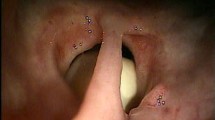Abstract
Purpose
Rectourinary fistula (RUF) is an uncommon but devastating condition that usually occurs as a complication of surgical treatment or radiotherapy of prostate cancer. Although operative fistula repair remains the most successful treatment, there still is no consensus concerning the management of RUF. We present first experiences and transanal surgical technique using biological mesh for fistula repair after urological intervention.
Material and methods
From January 2009 to December 2013, four cases of RUF were reported at our university hospital. Fistula occurred after extraperitoneal laparoscopic radical prostatectomy, open radical prostatectomy, and high-intensity focused ultrasound, respectively. All patients were initially treated with transanal Cook Biodesign™ mesh, whereas two patients received reoperation with rectal mucosa advancement flap and gracilis muscle flap interposition, respectively. Mean follow-up was 36 months (range 9–62).
Results
Fistula diameters ranged from 0.6 to 3.0 cm and were located 5 to 6 cm of anocutaneous line. The time from diagnosis to fistula repair was 3 to 7 weeks. The median operative time for Cook Biodesing™ mesh procedure was 79 min (IQR 60, 98). The initial success rate for biological mesh was 50 % (2/4 patients). Larger fistulae were minimalized successfully and finally closed with reoperation mentioned above. No deterioration of continence was documented.
Conclusions
Management of rectourinary fistula is still challenging. Using biomaterials for fistula closure seems to be a promising and minimally invasive transanal technique in future. Further analysis including more patients is needed to clarify its exact role in comparison to traditional surgical techniques.




Similar content being viewed by others
References
Kitamura H, Tsukamoto T (2011) Rectourinary fistula after radical prostatectomy: review of the literature for incidence, etiology, and management. Prostate Cancer 2011:629105
Shin PR, Foley E, Steers WD (2000) Surgical management of rectourinary fistulae. J Am Coll Surg 191:547–53
Falavolti C, Sergi F, Shehu E, Buscarini M (2013) York Mason procedure to repair iatrogenic rectourinary fistula: our experience. World J Surg 37:2950–5
Schwandner O, Fuerst A (2009) Preliminary results on efficacy in closure of transsphincteric and rectovaginal fistulas associated with Crohn’s disease using new biomaterials. Surg Innov 16:162–8
Pye PK, Dada T, Duthie G, Phillips K (2004) Surgisistrade mark mesh: a novel approach to repair of a recurrent rectovaginal fistula. Dis Colon Rectum 47:1554–6
Ellis CN (2008) Outcomes after repair of rectovaginal fistulas using bioprosthetics. Dis Colon Rectum 51:1084–8
Katz R, Borkowski T, Hoznek A et al (2003) Operative management of rectal injuries during laparoscopic radical prostatectomy. Urology 62:310–3
Polom W, Krajka K, Fudalewski T, Matuszewski M (2014) Treatment of urethrorectal fistulas caused by radical prostatectomy - two surgical techniques. Cent Eur J Urol 67:93–7
Youssef AH, Fath-Alla M, El-Kassaby AW (1999) Perineal subcutaneous dartos pedicled flap as a new technique for repairing urethrorectal fistula. J Urol 161:1498–500
Bukowski TP, Chakrabarty A, Powell IJ et al (1995) Acquired rectourethral fistula: methods of repair. J Urol 153:730–3
Wilbert DM, Buess G, Bichler KH (1996) Combined endoscopic closure of rectourethral fistula. J Urol 155:256–8
Smith AM, Veenema RJ (1972) Management of rectal injury and rectourethral fistulas following radical retropubic prostatectomy. J Urol 108:778–9
Borland RN, Walsh PC (1992) The management of rectal injury during radical retropubic prostatectomy. J Urol 147:905–7
Castillo OA, EM B o, Vitagliano GJ, Gomez R (2006) Anterior transanal, transsphincteric sagittal approach for fistula repair secondary to laparoscopic radical prostatectomy: a simple and effective technique. Urology 68:198–201
Boushey RP, McLeod RS, Cohen Z (1998) Surgical management of acquired rectourethral fistula, emphasizing the posterior approach. Can J Surg 41:241–4
Onaitis M, Ludwig K, Perez-Tamayo A et al (2006) The kraske procedure: a critical analysis of a surgical approach for mid-rectal lesions. J Surg Oncol 94:194–202
Author information
Authors and Affiliations
Corresponding author
Rights and permissions
About this article
Cite this article
Gierth, M., Denzinger, S., Liebig-Hörl, G. et al. Management of rectourinary fistula after urological interventions using biodesigned mesh: first experiences of an innovative technique. Int J Colorectal Dis 30, 1417–1422 (2015). https://doi.org/10.1007/s00384-015-2262-2
Accepted:
Published:
Issue Date:
DOI: https://doi.org/10.1007/s00384-015-2262-2




